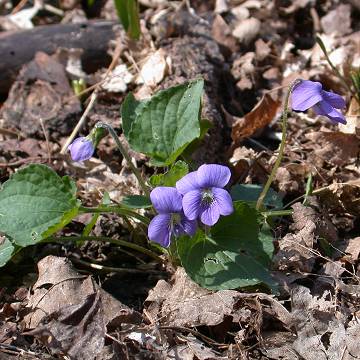

Viola sororia - (image 1 of 7)
Taxonomy
Family: Violaceae
Habitat
Disturbed woodlands, floodplains. Also in abandoned fields, lawns, degraded prairies.
Associates
Distribution
Newfoundland and Quebec west to British Columbia, south to FL, TX, and CA.
Morphology
Herbaceous perennial from a short, stout, oblique or horizontal rhizome, sometimes branching and colonial; glabrous to spreading-hairy. Leaves all basal, ovate to orbicular or reniform, acute to obtuse or rounded above, crenate-serrate, cordate at the base, the blade typically at an angle to the ascending petiole, to 13 cm wide in summer. Flowers about equaling the leaves or occasionally above them, 2-3 cm wide, relatively broad and open, appearing flat-faced; petals wide, deep violet to lavender or white; lateral petals densely bearded, the hairs 1 mm or more long and only slightly or not at all expanded distally; spurred petal glabrous or bearded, about as long as the laterals; cleistogamous flowers stout, on horizontal or erect peduncles. Fruit ellipsoid, surpassing the sepals; seeds dark brown.
Notes
Flowers mid April to mid June
Wetland indicator: Facultative -
Reproduces rapidly in a garden situation and sometimes regarded as a weed.
References
Gleason, Henry A. and A. Cronquist. 1991. Manual of Vascular Plants of Northeastern United States and Adjacent Canada. Second Ed.
The New York Botanical Garden. Bronx, NY
Swink, F. and G. Wilhelm. 1994. Plants of the Chicago Region.
Indiana Academy of Science. The Morton Arboretum. Lisle, Illinois.
|
Michael Hough © 2005 |